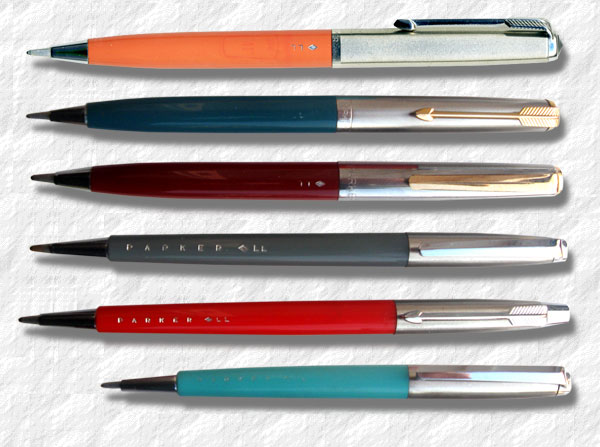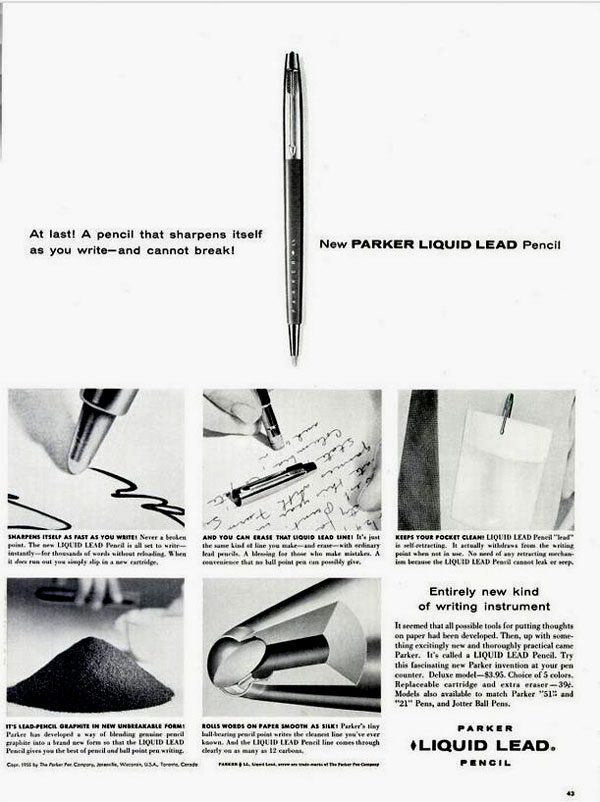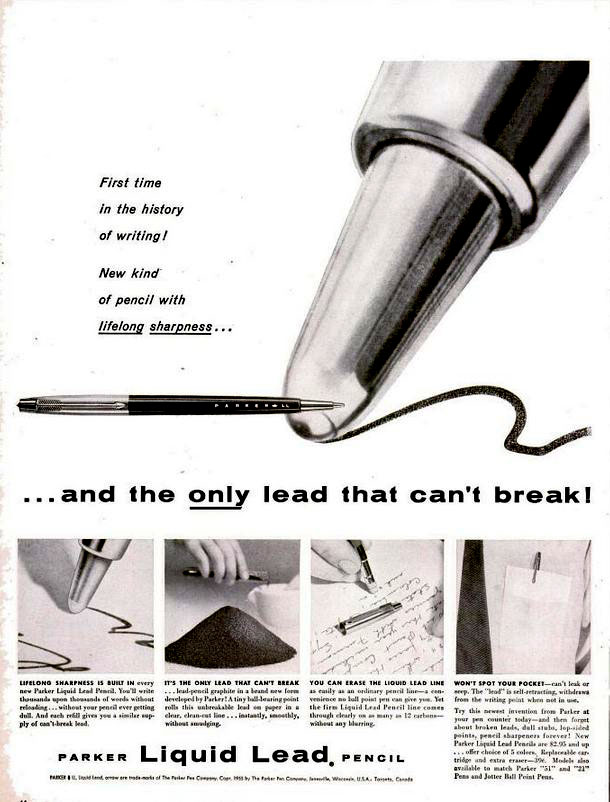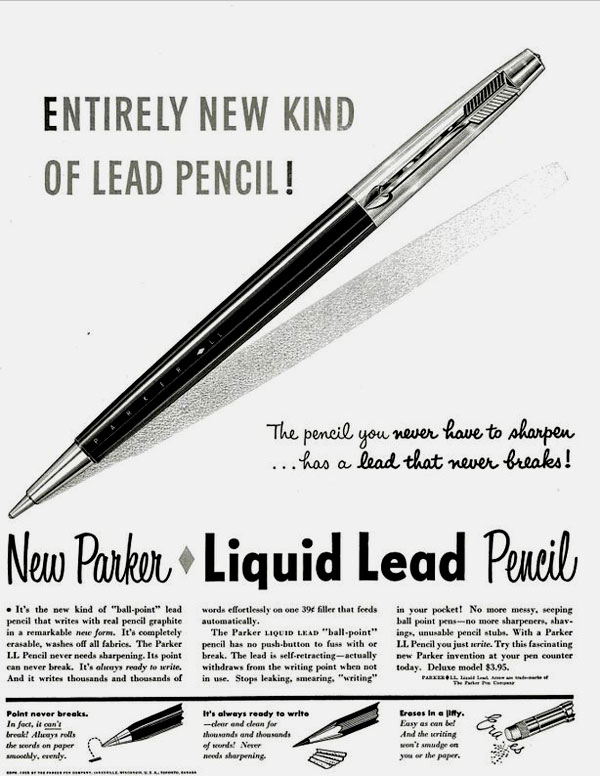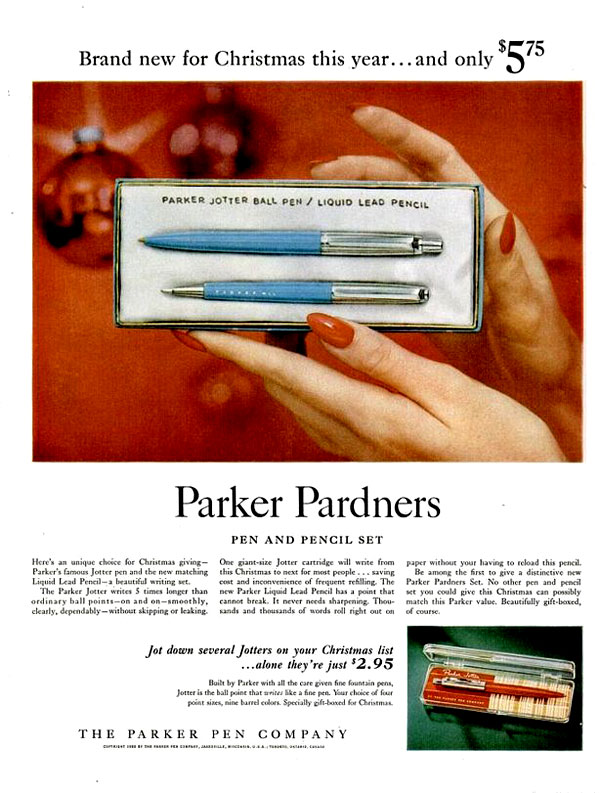
| parkerpens.net |
| PARKERCOLLECTOR.COM |
  1955- ca 1962 |
||
A little simplified one could call the Liquid Lead a ball point pen that wrote with liquid graphite, which made the writing erasable. At the time it was consider so innovative that it was exhibited at the Institute of Modern Art, in New York City. According to L. Graham Hogg in his book 50 years of the Parker Ballpoint pen it was mainly designed to be sold in sets with the fountain pens Parker “21”, and Parker “51”, but there are examples of many other designs, for instance a Canadian version pairing with the somewhat illusive Arrow. The Liquid Lead was added to the line rather than replacing the standard mechanical pencils, and also sold at the same price. |
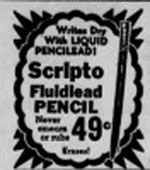 was already rolling off the production line. was already rolling off the production line.Well, both Scripto and Parker had the Biro/Reynolds/Eversharp “ballpoint patent wars” of the 1940’s in fresh memory and Parker had just begun to ship their own ballpoint pen, the Jotter, in the millions, so instead of getting into the patent fight that the industry expected, the two companies instead signed (in ink!) a record-fast agreement on Valentines day, February 14th, that allow them to use each other's formulas. |
|
A collection of different Liquid Lead Parkers. |
Dan Parker was the Executive Vice President at the time and he said: "We feel that with a high-quality standard, any imitators at a lower-quality level will find it pretty tough sledding." Prospective competitors would have needed to move fast indeed. When the news hit the papers in February of 1955, Scripto was already producing 60 000 fluid graphite pencils a day. “We are sold out well into May”, said Scripto’s President James V. Carmichael: "By the time we catch up with our present orders, we will be three million units behind." To cover all eventualities, Eugene P. Cofield Jr applied for a patent on behalf of Scripto in April 1955 and it was approved already in August the same year. |
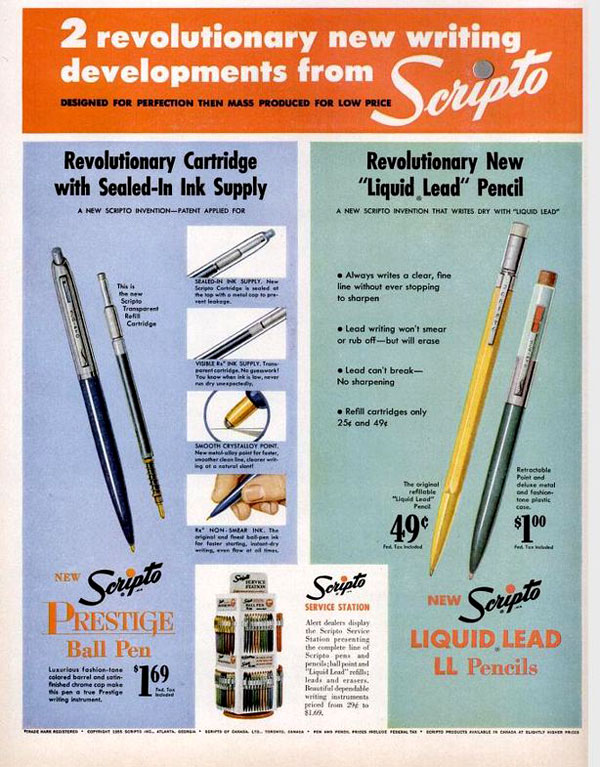 |
The Scripto Liquid Lead, 1955 ad. |
On Parker’s side of the fence Don Doman applied for a design patent in May 1955, it was approved in January of 1958. Also in 1955 the logo LL and LLP (Liquid Lead Pen) were filed as trade marks. |
|
Parker Liquid Lead ad 1955. |
There were Liquid Leads made in all the standard Parker “51” colours, and also a shorter model that was sold with with the Parker “51” Demi. They were fitted with Lustraloy or gold-filled Custom caps with Parker “51” style clips. Flighter and Signet Liquid Leads were also available. Indeed it was also paired with the early Jotters and sold as the Parker Pardner set in the colours of Black, Coral, Turqoise and Charcoal. Like the Jotter it was priced at $2.95 or as a Pardners’s set for $5.75. |
In 1956 a Parker “41” Liquid Lead was introduced, and in 1957 a Parker “61” version of the Liquid Lead was introduced. Both in the standard colours of the fountain pens. Parker sold two million units the first year of production. But it seems that interest faded with time. Some say the cartridges were too small and expensive, and the Liquid Lead was eventually phased out around 1962. The situation was about the same for Scripto. Already by 1957 the brand name Fluid Lead had replaced the Liquid Lead, and it was sold at a mere $29. By 1964 health problems forced Carmichael to step down from the Scripto presidency, although he continued several more years as chair of the board. He died in his home own Marietta at age sixty-two, on November 28, 1972. |
|
Parker Liquid Lead ads, 1955. |
David Cress, who worked at the Parker Technical division for many years, reveals that he and his collegues had the Sanford Research Institute work on a new Liquid Lead in 1981. He flew to California to work on the project while his collegue Bob Burkhalter flew to Germany to procure a dye. Bob Burkhalter also worked on invisible ink for the government. A special ball pen ink that disappeared when blown on with an acidic breath. To reveal the writing again, you took a basic substance like soap and rubbed it over the writing to make it visible again. Later, when they were owned by Gillette, Parker again worked on erasable inks containing thermoplastic block copolymers. |
The Liquid Lead pencils are collectible, but they suffer from the obvious flaw that the cartridges are no longer in production. Nevertheless, vintage cartridges sometimes still work, more that 40 years later. |
|
Parker Pardners ad 1956. |
© 1995-2019 Tony Fischier and The Parker Pen Company®/Sanford Ecriture.
This page is in no way sponsored by or created by the Parker Pen Company®. All opinions, views, and thoughts expressed herein are expressly the authors, and in no way reflect the opinions, views, or thoughts of the Parker Pen Company®/Sanford Ecriture. All logos and/or images on these pages are © Copyright of Parker Pen Company®Sanford Ecritureunless otherwise stated and is reprinted by kind permission. If You feel that Your copyright has been violated please contact the WEBMASTER.
Everything on this website is copyrighted by law and can not be used without written permission from the author, Tony Fischier. You may however use the information as reference material and although it is forbidden to make digital copies or reproductions it may be physically printed for personal use, which does not include use on other web pages or in advertising. You may however quote parts of the content of this website, digitally or physically, providing that the source and author is clearly stated, together with the copyright information. In the US referred to as Fair use. If you use any information on this site, add a link.
Feel free to donate a small sum through Paypal to help this site to stay online. Acknowledgements.
Parkercollector.com in translated versions
